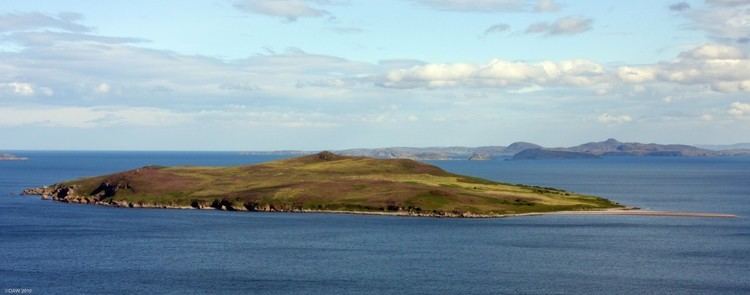Gaelic name Eilean Gruinneart Area rank 111 Area 196 ha Lieutenancy area Highland | OS grid reference NG945945 Council area Highland | |
 | ||
Meaning of name "Shallow firth", from Norse Highest elevation An Eilid 106 metres (348 ft) Island groups British Isles, Inner Hebrides | ||
Gruinard island anthrax biological warfare experiment great britain 1942
Gruinard Island (/ˈɡrɪnjərd/ GRIN-yərd; Scottish Gaelic: Eilean Ghruinneard) is a small, oval-shaped Scottish island approximately 2 kilometres (1.2 mi) long by 1 kilometre (0.62 mi) wide, located in Gruinard Bay, about halfway between Gairloch and Ullapool. At its closest point to the mainland it is just over 1.1 kilometres (0.68 mi) offshore. The island was made dangerous for all mammals by experiments with the anthrax bacterium, until it was decontaminated in the late 20th century.
Contents
- Gruinard island anthrax biological warfare experiment great britain 1942
- Map of Gruinard Island United Kingdom
- Gruinard island x base anthrax trials 1942 43
- Early historyEdit
- Biological warfare testingEdit
- Operation Dark HarvestEdit
- DecontaminationEdit
- References
Map of Gruinard Island, United Kingdom
Gruinard island x base anthrax trials 1942 43
Early historyEdit
The island was mentioned by Dean Munro who travelled the area in the mid 16th century. He wrote that it was Clan MacKenzie territory, was "full of woods", (a striking comparison with its treelessness today) and that it was "guid for fostering of thieves and rebellis".
The population was recorded as six in 1881, but Gruinard has been uninhabited since the 1920s.
Biological warfare testingEdit
Gruinard was the site of a biological warfare test by British military scientists from Porton Down in 1942, during the Second World War. At that time there was an investigation by the British government into the feasibility of an attack using anthrax. Given the nature of the weapon which was being developed, it was recognised that tests would cause widespread and long-lasting contamination of the immediate area by anthrax spores. To limit contamination, a remote and uninhabited island was required. Gruinard was surveyed, deemed suitable and requisitioned from its owners by the British Government.
The anthrax strain chosen for the Gruinard bioweapons trials was a highly virulent type called "Vollum 14578", named after R. L. Vollum, Professor of Bacteriology at the University of Oxford, who supplied it. Eighty sheep were taken to the island and bombs filled with anthrax spores were exploded close to where selected groups were tethered. The sheep became infected with anthrax and began to die within days of exposure.
Some of the experiments were recorded on 16 mm colour movie film, which was declassified in 1997. One sequence shows the detonation of an anthrax bomb fixed at the end of a tall pole supported with guy ropes. When the bomb is detonated a brownish aerosol cloud drifts away towards the target animals. A later sequence shows anthrax-infected sheep carcasses being burned in incinerators following the conclusion of the experiment.
Scientists concluded after the tests were completed that a large release of anthrax spores would thoroughly pollute German cities, rendering them uninhabitable for decades afterwards. These conclusions were supported by the discovery that initial efforts to decontaminate the island after the biological warfare trials had failed because of the high durability of anthrax spores.
In 1945, when the owner sought the return of Gruinard Island, the Ministry of Supply recognised that the island was contaminated as a result of the wartime experiments and consequently it could not be derequisitioned until it was deemed safe. In 1946, the Crown agreed to acquire the island and to take on the onus of responsibility. The owner or her heirs and beneficiaries would be able to repurchase the island for the sale price of £500 when it was declared "Fit for habitation by man and beast".
For many years it was judged too hazardous and expensive to decontaminate the island sufficiently to allow public access. Gruinard Island was quarantined indefinitely as a result. Visits to the island were prohibited, except periodic checks by Porton Down personnel to determine the level of contamination.
Operation Dark HarvestEdit
In 1981 newspapers began receiving messages with the heading "Operation Dark Harvest" which demanded that the government decontaminate the island, and reported that a "team of microbiologists from two universities" had landed on the island with the aid of local people and collected 300 lb (140 kg) of soil.
The group threatened to leave samples of the soil "at appropriate points that will ensure the rapid loss of indifference of the government and the equally rapid education of the general public". The same day a sealed package of soil was left outside the military research facility at Porton Down; tests revealed that it contained anthrax bacilli. A few days later another sealed package of soil was left in Blackpool, where the ruling Conservative Party was holding its annual conference. The soil did not contain anthrax, but officials said that the soil was similar to that found on the island.
DecontaminationEdit
Starting in 1986 a determined effort was made to decontaminate the island, with 280 tonnes of formaldehyde solution diluted in seawater being sprayed over all 196 hectares of the island and the worst-contaminated topsoil around the dispersal site being removed. A flock of sheep was then placed on the island and remained healthy.
On 24 April 1990, after 48 years of quarantine and four years after the solution being applied, junior defence minister Michael Neubert visited the island and announced its safety by removing the warning signs. On 1 May 1990, the island was repurchased by the heirs of the original owner for the original sale price of £500.
As of October 2007 there have been no cases of anthrax in the island flock.
